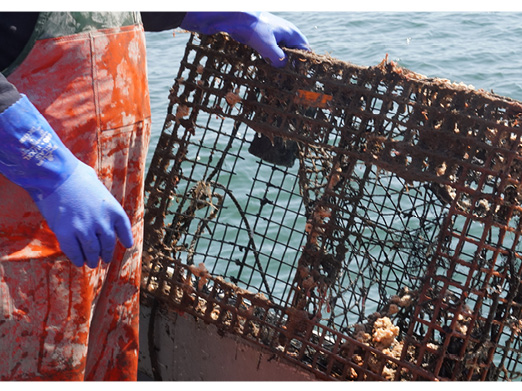By David Seigerman, clean water communications specialist
Drinkable, Fishable, Swimmable.

Save the Sound has teamed up with The Maritime Aquarium at Norwalk, Project Oceanology, and the Cornell Cooperative Extension of Suffolk County to remove thousands of abandoned lobster traps littering the bottom of Long Island Sound. © savethesound.org
Sounds pretty simple, doesn’t it? Straightforward, unassailable, as fundamental as those other guiding principle triplets: “Life, Liberty, and the Pursuit of Happiness” or “Truth, Justice, and the American Way.” It seems the least we can expect from the water that we drink, pull food from, play in, and sail on, is that it be clean and safe.
That’s what the Clean Water Act (officially, the Federal Water Pollution Control Act Amendments of 1972) sought to ensure when it was enacted 50 years ago this fall. Laws, however, are only as effective as they are enforceable, which is why “Drinkable, Fishable, Swimmable” is more than a motto. It is the mission statement of an organization called the Waterkeeper Alliance, an international network of more than 300 groups protecting over 2.5 million square miles of water bodies across the planet.
“Regulatory agencies do a lot of good work, but they’re heavily burdened and chronically underfunded so we fill gaps in enforcement,” said Long Island Soundkeeper Bill Lucey, who works within Save the Sound to safeguard Long Island Sound. “Waterkeepers mobilize local people, who are very familiar with their bodies of water. Waterkeepers come in all flavors and sizes, and all have their own local perspective when it comes to dealing with problems.”
Take the ongoing initiative to remove thousands of abandoned lobster traps lost in Long Island Sound after pollutants and warming waters decimated the fishery. Four years after legislation was passed in Connecticut to allow for trap removal at the bottom of the Sound, Lucey and four local entities – The Maritime Aquarium at Norwalk, Project Oceanology in Groton, and the Cornell Cooperative Extension of Suffolk County on Long Island, and Save the Sound – finally are underway adding Connecticut waters to the cleanup effort initiated in New York more than a decade ago. Their goal: retrieve 3,000 traps in Connecticut over two years. One ghost trap recovered this spring was last fished in 1993, and belonged to a fisherman whose career began in the 1930s. The few remaining members of the region’s lobster fleet are a critical component, providing their expertise, boats, and local knowledge of the Sound.
Lobster trap retrieval is more than overdue debris cleanup. Some unattended pots are still capturing lobsters, fish, and other sea life, and remaining ropes present entanglement risks. It’s also about fighting the escalating problem of pollutants like plastic.
“Plastic pollution is definitely a Clean Water Act component,” said Lucey. “There’s plastic breaking off the vinyl coating of the traps and rope fibers. We want to get it out of the water before it completely breaks down and enters the Sound.”
In other words, it’s about protecting and preserving the Sound, keeping its waters drinkable, fishable, and swimmable. And doing so in classic Waterkeeper fashion.
“We find a problem in a watershed, get a group of different people together, define the problem, design a solution, get funding, act on it,” said Lucey. “And you have to be persistent. When you have local people concerned about their own waters, they’re going to bring that persistence. They live there, they’re going to be there, so they’re in the fight until they win.”
Lucey’s duties extend well beyond the lobster pot project. For years, he’s been patrolling the Sound, from Rikers Island to Plum Island, proactively monitoring water quality on the New York and Connecticut coastlines and responding to dozens of pollution calls every year. Like original Long Island Soundkeeper Terry Backer before him, he also acts as a voice for the Sound in Hartford, Albany, and D.C.
As demands grow, so do his capacities. This June, a Soundkeeper Associate was added to his team, giving him a much-needed second boat out on the water this summer. Emma Deloughry comes into the position well acquainted with Waterkeeper responsibilities, having worked with Lucey as an intern last year and with the Congaree Riverkeepers and Charleston Riverkeepers in South Carolina. She even produced a documentary on plastic pollution.
Technology also adds to the Soundkeeper’s growing toolbox. Lucey expects to begin using drone-mounted thermal cameras this winter, checking for hot spots in culverts. Where warm water is identified, samples can be taken to determine whether it’s groundwater or a sewage problem.
“The thing about the Clean Water Act everyone needs to realize,” said Lucey, “is that all citizens of the U.S. have standing in federal court when their water is polluted. We all drink it, we all fish in it, we all boat in it. It’s our right under the law to defend it.” ■




